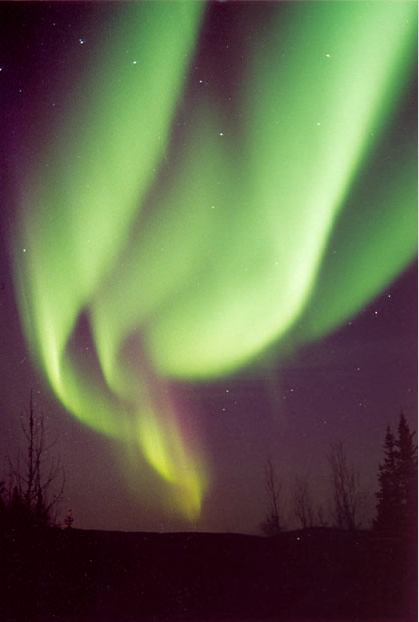Auroral curtains, Alaska
Auroral Curtains, Alaska: A Mesmerizing Display of Natural Phenomenon
The enchanting spectacle of auroral curtains illuminating the Alaskan sky is a sight to behold. These ethereal displays, composed of nearly rayless curtains of green atomic oxygen emission, captivate observers with their beauty and mystery. Although the original article provided a brief glimpse into this atmospheric optics phenomenon, let us delve deeper into the intricacies of auroral curtains in Alaska.
Auroral curtains, also known as aurora borealis or the northern lights, are a result of interactions between charged particles from the sun and the Earth's magnetic field. When these charged particles, primarily electrons and protons, enter the Earth's atmosphere near the poles, they collide with atoms and molecules, exciting them to higher energy states. As these excited particles return to their original states, they emit light of various colors, including the iconic green hue seen in Alaskan auroras.
Alaska's unique geographical location makes it an ideal vantage point for observing auroral curtains. Situated close to the Earth's magnetic poles, Alaska experiences frequent and intense geomagnetic activity, increasing the likelihood of witnessing these awe-inspiring displays. The pristine wilderness and clear skies of Alaska further enhance the viewing experience, offering unobstructed vistas of the dancing lights.
The green color dominating auroral curtains in Alaska is primarily caused by the emission of atomic oxygen at a wavelength of 557.7 nanometers. When excited electrons collide with oxygen molecules in the Earth's upper atmosphere, they cause the oxygen atoms to emit this distinct green light. The intensity and structure of the curtains can vary, ranging from diffuse glows to well-defined arcs and rippling curtains that span across the sky.
Photographers and enthusiasts often capture stunning images of these celestial wonders. The photograph taken by Jan Curtis on October 4, 2000, showcases the remarkable beauty of auroral curtains in Alaska. The almost rayless curtains, devoid of distinct rays or beams, create a mesmerizing visual effect as they envelop the night sky. This particular image exemplifies the ethereal nature of auroral displays, leaving viewers in awe of nature's artistic prowess.
To fully appreciate the grandeur of auroral curtains in Alaska, it is important to understand the science behind their occurrence. The solar wind, a stream of charged particles constantly emitted by the sun, interacts with the Earth's magnetosphere. When the solar wind encounters areas of increased magnetic activity, such as the polar regions, it can breach the Earth's magnetic field, allowing charged particles to enter the atmosphere and create auroras.
The intensity and frequency of auroral displays in Alaska vary depending on solar activity and geomagnetic storms. During periods of heightened solar activity, such as solar flares or coronal mass ejections, the influx of charged particles intensifies, leading to more vibrant and widespread auroras. Geomagnetic storms, caused by disturbances in the Earth's magnetic field, can also enhance auroral activity, resulting in even more spectacular displays.
Witnessing auroral curtains in Alaska is truly a once-in-a-lifetime experience. The interplay of vibrant colors, dynamic movements, and the surrounding natural beauty creates an atmosphere of enchantment and wonder. It is a testament to the marvels of our planet and the intricate dance between the sun, Earth's magnetic field, and the atmosphere. Whether you are a seasoned photographer or an avid nature lover, a trip to Alaska to witness these captivating auroral curtains is an adventure that should not be missed.

Auroral Curtains, Alaska
Photographed October 4, 2000 by Jan Curtis (Aurora site).
Nearly rayless curtains of green atomic oxygen emission swathe themselves across the Alaskan sky.
Image ©Jan Curtis, shown with permission.
Note: this article has been automatically converted from the old site and may not appear as intended. You can find the original article here.
Reference Atmospheric Optics
If you use any of the definitions, information, or data presented on Atmospheric Optics, please copy the link or reference below to properly credit us as the reference source. Thank you!
-
<a href="https://atoptics.co.uk/blog/auroral-curtains-alaska/">Auroral curtains, Alaska</a>
-
"Auroral curtains, Alaska". Atmospheric Optics. Accessed on April 19, 2024. https://atoptics.co.uk/blog/auroral-curtains-alaska/.
-
"Auroral curtains, Alaska". Atmospheric Optics, https://atoptics.co.uk/blog/auroral-curtains-alaska/. Accessed 19 April, 2024
-
Auroral curtains, Alaska. Atmospheric Optics. Retrieved from https://atoptics.co.uk/blog/auroral-curtains-alaska/.